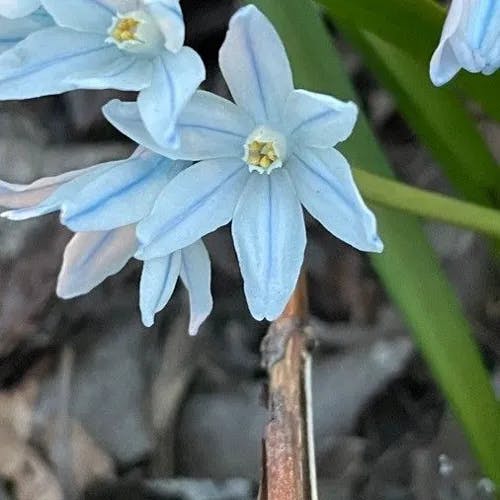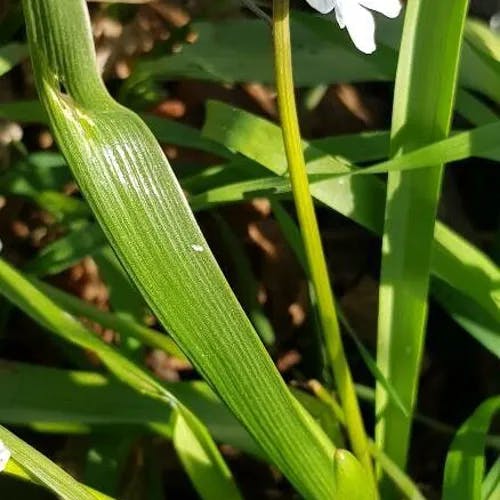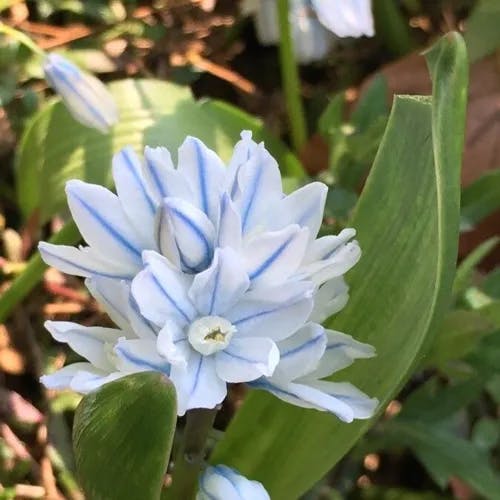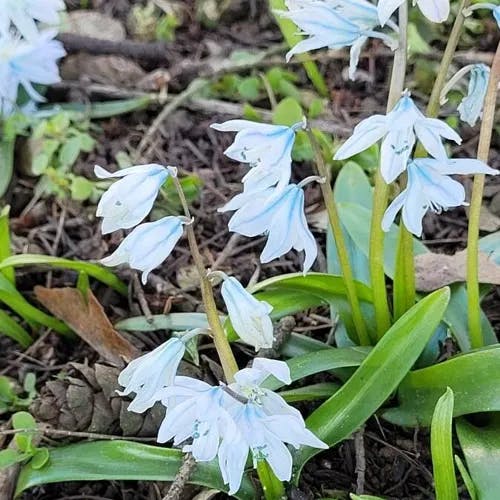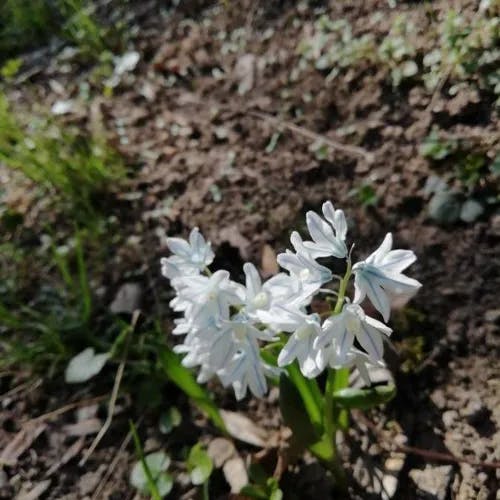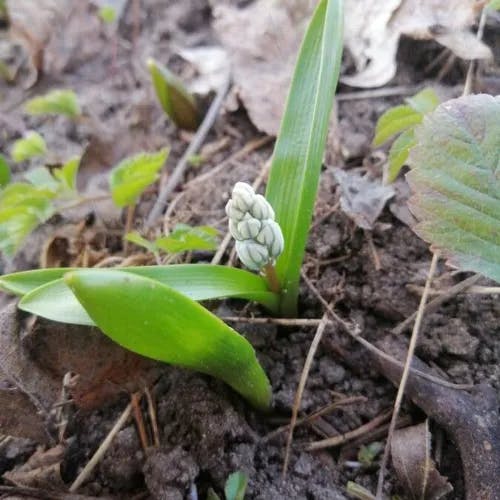The perennial bulbous plant Puschkinia scilloides, native to the Caucasus region and Turkey, is often cultivated as an ornamental in gardens and parks for its pretty blooms. In early springtime from March to April, this hardy plant produces dense clusters of small star-shaped flowers on upright 15-20 centimeter stems. The six petals on each tiny flower can be white or pale blue in color. Reaching just 10-15 centimeters in width at maturity, Puschkinia scilloides is easy to grow in well-drained soil with partial sun exposure. Resistant to pests, diseases and drought when established, this low maintenance plant has round fruits containing seeds for reproduction. Also called striped squill, its name Puschkinia honors Russian botanist Apollo Mussin-Pushkin. The word scilloides refers to its resemblance to Scilla genus plants. Representing hope and new beginnings in floral symbolism, charming Puschkinia scilloides can beautifully enhance any garden with its delicate flowers and easy cultivation.
Striped-squill
- Scientific name
- Puschkinia scilloides
Basic Information
- Asparagaceae Family Puschkinia Genus Striped-squill Species
- Asparagaceae > Puschkinia > Puschkinia scilloides
- 83%
- The Completeness of This Encyclopedia
Please help us complete the encyclopedia, Terrarium is a encyclopedia service to be completed with everyone in the world. Currently, this page is 83% complete. For more information on how to contribute, please click here.
- Flower
- Forb/herb
- Perennial
- Height
- 15cm ~
- Flower Color
- Leaf Color
- Anthesis
- spring
- Sunlight Exposure
Full Sun Long hours of sunlight from morning to afternoon Partial Shade A location in the shade of a tree or where either the morning or afternoon is shaded Full Shade A place where there is no direct sunlight
- Full Sun
- Hardiness Zones
This is an indicator to know to which zone each plant can winter. Knowing the zone of each plant gives you an idea of the cold temperature resistance when grown in the ground without a roof. 2: -42.7 to -40.0 3: -39.9 to -34.4 4: -34.3 to -28.9 5: -28.8 to -23.3 6: -23.2 to -17.8 7: -17.7 to -12.2 8: -12.1 to -6.7 9: -6.6 to -1.1 10: -1.0 to 4.4 11: 4.5 to 10.0
- 4
- Cold resistance
- Excellent
- Heat resistance
- Fair
- Habitat of origin
- Russia, Turkey
- Growth Rate
- Normal
What is Striped-squill (Puschkinia scilloides)?
What is Striped-squill (Puschkinia scilloides)
Flower meaning
The flower language linked with the Striped-squill herb in the U.S. denotes optimism. This wildflower frequently symbolizes positive thinking, cheerfulness, and confidence in superior eras ahead. It communicates support and heartening to individuals navigating tribulation or obstacles. The Striped-squill's fragile and splendid inflorescences embody the notion that despite hardship, there is always anticipation for a more promising tomorrow. It is not deemed a birth blossom for any exact month or date. The lexicon of posies is a style of imparting emotions and attitudes via the bestowal of posies over centuries.
Calendar of Striped-squill (Puschkinia scilloides)
Calendar
Puschkinia scilloides, also referred to as Striped-squill, has a native area encompassing the Caucasus region. Between March and April, the perennial plant typically produces blooms in the United States. The flowers showcase their graceful blue and white striped petals during this period, which is the peak blooming time for Striped-squill. For around 2 to 3 weeks, the blooms are at their best. Planting bulbs in soil with good drainage and adequate sunlight exposure can prolong the blooming period. Additionally, routine watering during the growing season aids in extending the flowering time. Striped-squill is an attractive garden plant suited to USDA hardiness zones 4-8.
How to grow Striped-squill (Puschkinia scilloides)
Watering
The optimal schedule and technique of hydrating the Striped-squill depends on the time of year and dirt dampness. In the growing time, typically spring and early summer, the Striped-squill necessitates consistent watering to preserve soil wetness. It is counseled to hydrate the flora once every 7-10 days, ensuring the soil is evenly moist but not waterlogged. The quantity of water required can differ based on the specimen's extent and container it inhabits, but generally, hydrating until the top inch of soil is moist suffices. Contrastingly, in the dormant time, late summer and autumn, the Striped-squill necessitates less frequent hydration. It is advisable to reduce hydrating to once every 2-3 weeks, permitting the soil to dry out slightly between hydrations It is imperative to note overhydrating can lead to root rot, so it is crucial to observe the soil wetness levels and adjust hydrating fittingly. The Striped-squill requires moderate sunlight exposure to thrive. It performs best in partial shade conditions receiving a few hours of direct sunlight per day. Too much sunlight can cause leaf scorching, while too little light will result in stunted growth. The ideal temperature range is 60-75°F. Avoid exposing this plant to freezing winter temperatures. Use well-draining porous soil and provide humid conditions. Fertilize monthly during the growing season. Propagate by dividing rhizomes in spring or from seed after a cold stratification period.
Soil and Fertilizer
The horizontally banded Puschkinia scilloides blossoms optimally in loose, organic-enriched ground averaging between slightly acidic and neutral. Prefer sandy loam topsoil with suitable drainage, avoiding waterlogging which can decay roots. Apply equal nitrogen, phosphorus, potassium fertilizer when emerging from rest. One tablespoon per square foot guideline. Reapply time-released plant food every 4-6 weeks during growth to steadily nourish. Tailor amount based on response and soil analysis, requiring routine testing for ideal pH and nutrients, then amending as needed.
Sunlight and Place
The striped-squill can not handle temperatures hotter than 30 Celcius degrees. Stripe-squill grows well when the temperature stays between 15 and 25 Celcius degrees. In summer, providing shadow shields the striped-squill from too much hotness. The striped-squill handles cold temperatures down to minus 10 Celcius degrees. Areas with mild winters enable overwintering the striped-squill outside. For areas with harsh winters, bring the striped-squill inside or cover it. The plant needs a minimum of 6 hours of direct sun every day. Place the striped-squill where it gets the maximum sunlight.
Advanced Information of Striped-squill (Puschkinia scilloides)
Pruning
The Puschkinia scilloides, colloquially Striped-squill, needs habitual cutting for maximum wellness. After efflorescence ceases, utilize sharpened shears to excise any withered or diseased stems and leaves, leaving some stem. Dispose of pruned detritus correctly. Water and fertilize suitably post-pruning. Mulch too, for regrowth. Check for infestations; use preventives if required. Careful pruning assists the bulbous plant's development, regulates proportions, upgrades visuals by removing unsightly dying parts, and deters maladies. Combining pruning with attentive aftercare ensures the perennial blooms optimally.
Planting and Harvest
The small bulbous herb named Striped-squill, scientifically called Puschkinia scilloides, could be grown in pot or garden bed. When planting in pot, ensure container has drainage holes at base. Mix free-draining soil blend and place bulb just above surface. After planting, water thoroughly and keep moist, not soaked. Situate pot at location with bright, indirect sun beams. To plant in ground, select site with fast-draining dirt and partial shade. Excavate deep enough hole to fit bulb with top slightly protruding above ground. Return excavated soil, packing lightly around bulb. Water deeply after planting and keep soil damp, not waterlogged. To transplant, wait until flowering ends and leaves die back. Carefully extract bulb, gently separating any offshoots formed. Replant bulbs in fresh soil mix using same steps as initial planting. Faulty care leads to poor growth and flowering. Supply correct quantity of water, sunlight, and temperature. Overwatering causes bulb rot while underwatering stunts growth. Prefers coolness and may not tolerate hot, arid conditions. Routinely check for pests or diseases and take appropriate actions if found.
Propagation
Striped-squill, also called Puschkinia scilloides, can spread through various techniques like sowing seeds, bifurcation, and clippings. To spread through seeds, compile mature seeds and scatter them in well-draining mud during the fall or early spring. Lightly blanket the seeds with mud and maintain them moist until germination manifests. Bifurcation is another efficacious technique, best accomplished in early autumn. Conscientiously excavate the plant and dissociate the bulbs, ensuring each bifurcation has adequate roots. Replant the bifurcations at the same profoundness as earlier. Clippings can be taken from the basal shoots in early summer. Eliminate a robust shoot and locate it in a well-draining potting amalgam. Maintain the clipping moist and endow indirect luminosity until roots expand. Leaf clippings are not functional for Striped-squill. Harvesting is not imperative for propagation intentions.
Pests and Diseases
The speckled-squill (Puschkinia scilloides) are receptive to several nuisances and illnesses. An average nuisance impacting the plant is the egg mite (Rhizoglyphus spp.). The minute acarids nourish themselves on the corms of the speckled-squill, impairing the plant. Scrutinizing the egg prior to planting and casting away any demonstrating indications of acarid bustling can inhibit attack. Furthermore, upholding noble backyard hygiene by ridding plant residues and weeds can diminish risks of infestation. Another nuisance impacting speckled-squill is the daylily egg fly (Merodon equestris). The larvae nourish themselves on the eggs, prompting desiccation and eventual decease of the plant. Installing eggs in well-drained topsoil and refraining from overwatering can inhibit attack. Employing insecticides intended for egg flies can efficaciously diminish their populace. Concerning afflictions, speckled-squill are receptive to egg decay elicited by fungous pathogens resembling Botrytis spp. and Fusarium spp. These pathogens flourish in damp settings and can infect the eggs, eliciting rotting. Installing eggs in well-drained topsoil and refraining from overwatering can inhibit egg decay. Appropriate spacing amid plants can enhance air diffusion and diminish risks of fungous contaminations.
Habitat of Striped-squill (Puschkinia scilloides)
Habitat
Toxicity of Striped-squill (Puschkinia scilloides)
Health Benefits
- edible
- Inedible
- Toxic
- No toxicity
NO DATA
Toxic for dogs and cats
NO DATA
Q&A of Striped-squill (Puschkinia scilloides)
- Is there a recommended way to choose Puschkinia scilloides?
The bulb-shaped Striped-squill originates as a springtime plant of aesthetic value and systematic denomination Puschkinia scilloides. When picking varieties, observe chromatic patterns and flower dimensions. The widespread sort 'Alba' unveils pallid petals with azure stripes. 'Libanotica' alternatively dons lighter blue with deeper stripes. 'Alba' suits classic white preferences, while 'Libanotica' incorporates blue tones in the yard. When obtaining seeds, choose plump, undamaged ones. Shun discolored or withered seeds. Before planting, soak seeds in water to further germination. If acquiring seedlings, verify health, no disease or pests, mature roots, and avoid harm. Transplant into draining soil, supply sunlight and water for ideal maturation. Mindfully follow specific instructions for planting and nurturing Striped-squill to ensure thriving cultivation.
